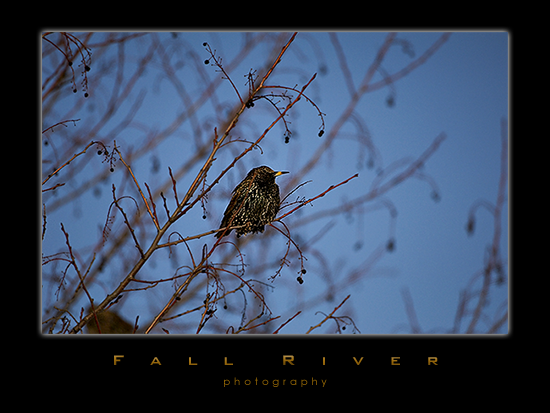Can’t see the trees
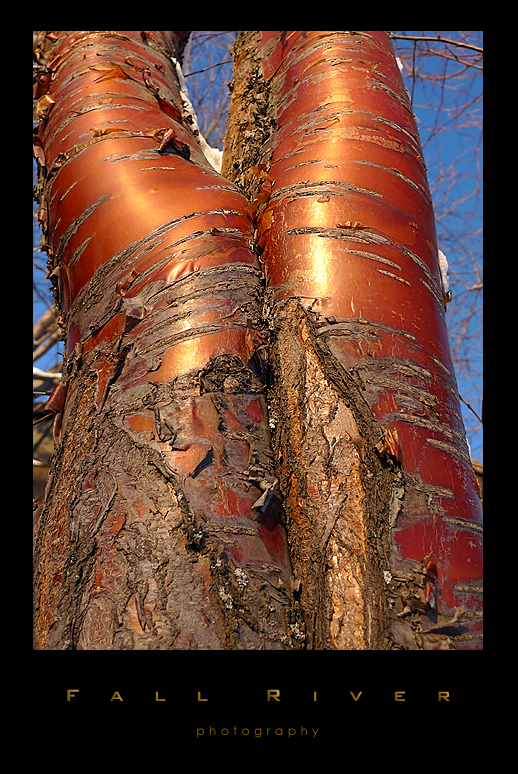
Sometimes, well often times, we get so focused on something we don’t see everything in the picture. While we were photographing the European Starlings and the Bohemian Waxwings we didn’t notice the tree they were in. The color of that paper birch was just glowing. It had an intensely copper look to it that was unimaginable. Very beautiful.
Hello Starling
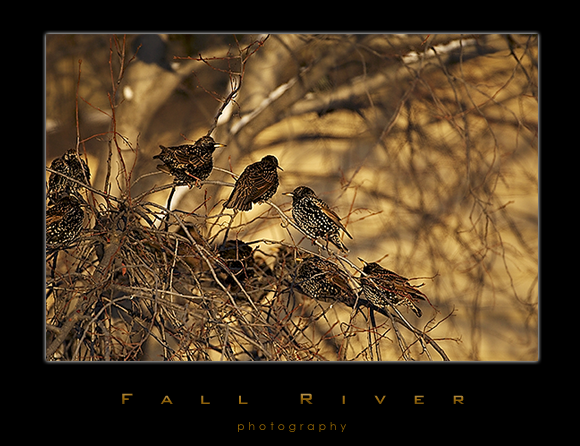
European Starlings were on show also. The trees were hanging thick with berries and with the howling wind and cold temps of the week leading up they were out making up for lost feeding time.
Must be Winter
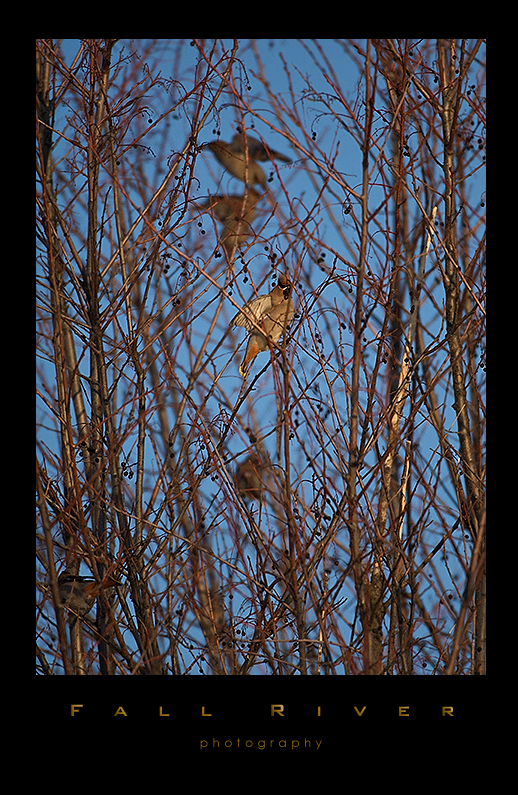
Well it must be winter finally. The temps plummeted last weekend to a crisp -18 degrees. Lovely. And I mean that. There is hardly a better day to be had than a crisp cold day with the sun out. When it gets to the double digit negative you know that the frost crystal are coming soon! That’s when winter gets magical. Oh yeah, since the weather was so very Alaska like (finally) the Bohemians were out for some berries. Love those birds.
Hello!
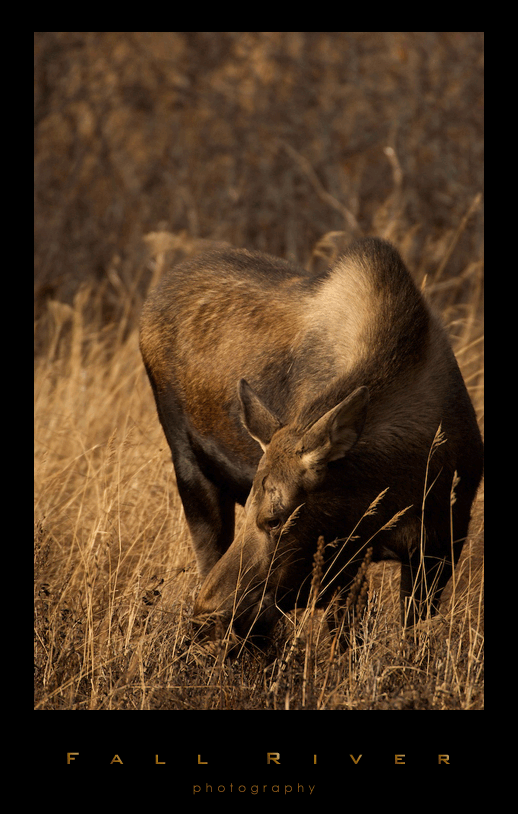
The next thing I see is this female moose laying quietly in the tall grass. Looking around I spy 3 more females, another spike, and a huge bull. So I decide to work my way into them (I got a 2 on my SATs). I moved across the open area and up on a hill about 75 feet from the female and set up the camera. The big bull was looking down hill so at this point all I can get from him is the back of his head. This female decides that she wants to do some grazing and she gets up right in front of me. Okay, that’s good, she is working slowly in my general direction but nothing to worry about. When she gets about 25 feet away from me I decide to move where I think she is not going. I am wrong. She looks up and starts walking directly for me. I wave at her and she stops dead and her ears poke straight up. Incredible, she did not even know I was there. So now I can sense she is on full alert, and she decides to check me out. She walks right up to me. Now, people get killed by moose up here. There are more deaths from them than from grizzly bears by a large margin. Also, moose have been known to kill a grizzly bear. They are very powerful and basically they can kick you to death, and the Alaska moose is notorious for a grumpy disposition. All of this makes me nervous at this point. So then she snorts right at me and she is so close I can feel it. Look away, look away…that’s all I can think. She stares holes in me and I just glance at her and smile a little a bit and think “I must to go to my happy place, I must go to my happy place” because things are going to get real ugly if I send out bad vibes. All this time I am praying, and I mean praying hard, that that bull does not hear what is going on, because if he does….I am toast. Messing with a bull moose in his rut is unwise, messing with his harem is dangerous. Finally she decides I am nothing to worry about and drops her head and starts feeding right there. Me? ummm, I’m moving…
While I was waiting….
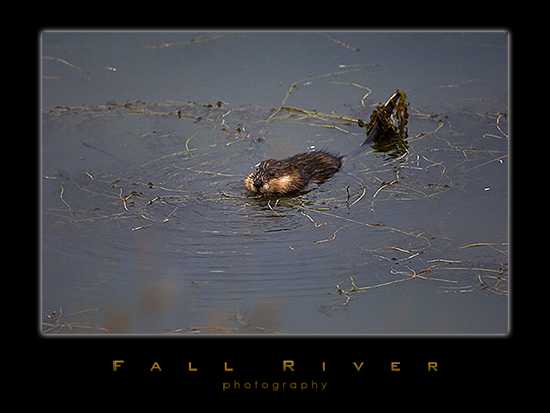
There is an unusual happenstance of note in that a Great Blue Heron has decided to grace the Great State with it’s presence. I was at Potters Marsh waiting for the our beautiful friend to wake and while he slept and I waited, this muskrat was very busy scooting around the pond. He would shoot by the GBH and the heron would lift his head for a moment and then go back to sleep, the muskrat would then chase the incoming ducks away too. He seemed to think he owned the joint. I didn’t argue, I just shot him.
Juvies
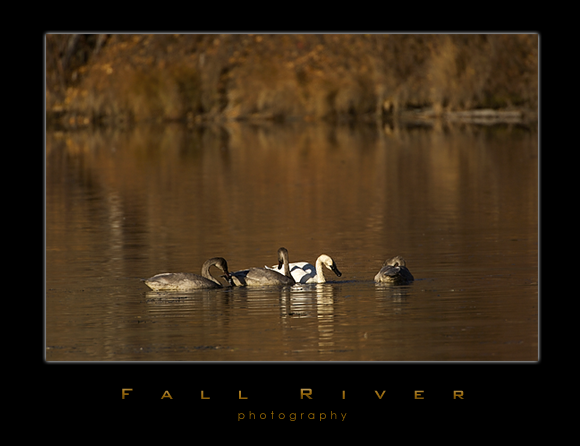
We headed over to Jim Lake yesterday morning to look for some water fowl photographic opportunities and we were rewarded handsomely. We found 4 different groups of adults and juveniles feeding, frolicking and generally doing what swans do. It was a beautiful day here in Alaska with temps (amazingly) in the 50s. We had a very healthy dose of termination dust last week and its all gone at the moment. The swans were really enjoying the weather and feeding actively. The red salmon were in and thrashing around but unfortunately due to the mortality that is involved in the end of life cycle for salmon the smell was a bit tepid. Great day to be out and about.
Alaska Swans
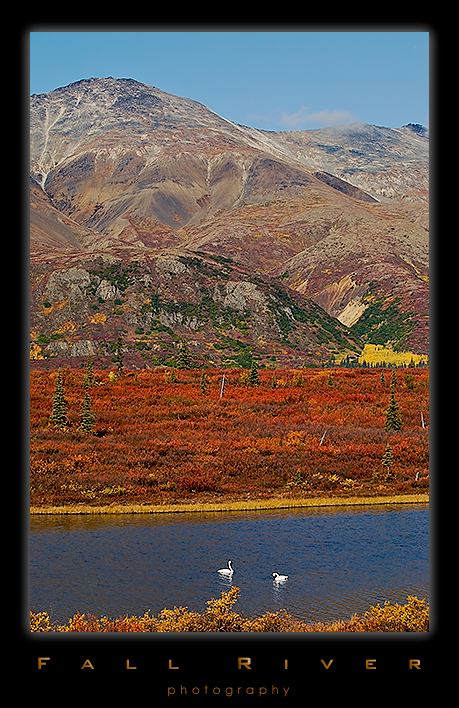
As we headed up the Parks Highway to our first location we saw these swans in a lake off the roadside. The fall colors are in full bloom and the swans were cooperative so we took advantage and had a seat on the tundra, ate some blueberries and photographed the swans. They cruised around for a little while then started feeding. If you have seen water fowl feed it’s a bottoms up routine. At that point we said goodbye and headed on our way. The swans usually stick around until the ice freezes up the water so much they loose their take off runway so they will still be here for a while.
Morning On The Flats

I headed out this morning to the Palmer hay flats to see what I could get in the lens by way of our migratory bird population. I was up early and set up and got to see a magnificent sunrise with the mist hanging off the valley. Birding itself was slow, I could hear the Sandhill Cranes whooping it up just out of sight in the high thrushes and I kept waiting for a lift off. They like to warm up in the sun first. They never did though, I guess they were happy to be where they were. That’s a good thing.
The King Eider
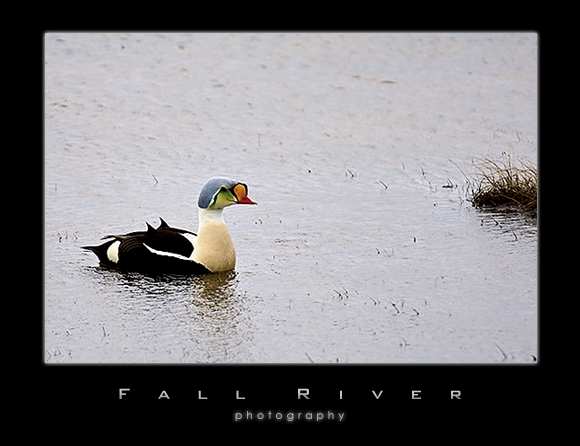
Somateria spectabilis, The King Eider is a large, ornately plumaged duck that spends the predominate portion of its life in the very far north. Its breeding grounds in the Americas are in the Arctic and the North West Territories and it winters mostly no farther south than the Aleutian Islands. In addition it spends the predominate portion of its life out on the remote northern waters and therefore is not easily observable.
The King Eider population migrates very early, sometimes to their own detriment, flying across the tundra in flocks reported at up to 113,000 in one half hour period. Now these birds fly at about 60 km/hr at less than 100 meters off the ground. Imagine yourself on the Arctic tundra with over one hundred thousand birds, flying less than three hundred feet over your head, at forty miles an hour. Wow. And these migrations can fill the sky for hours, ten hours in the case of this particular report.
The Chow Line
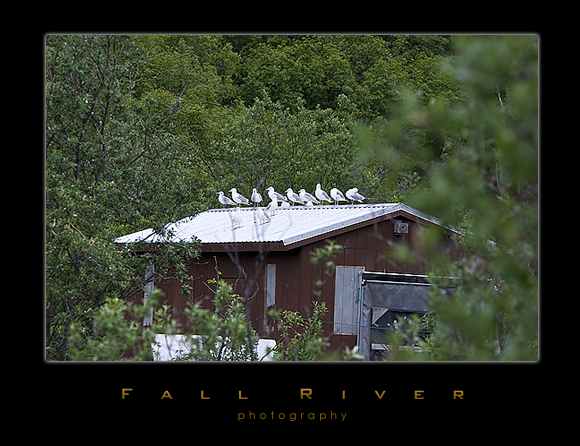
We passed a hatchery along the River on the Richardson highway and the Gulls were out in force. They were gorging themselves on the newly released fry apparently. They would line up on this roof and then swoop down and gobble some hatchlings up and then return to the end of the chow line and roost for a while. I don’t know how much Fish and Game is paying to feed the gulls but I hope they put enough in for the rest of us to catch some. What you see hear is a fraction of the hundred or so that were taking advantage of the free meal.
Gavia stellata: Red-throated Loon
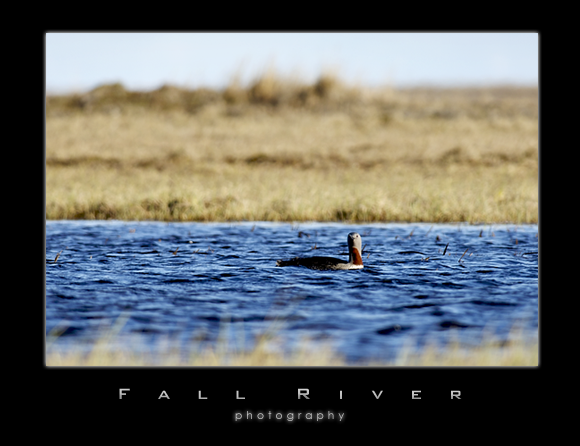
The ponderously beautiful Red-throated Loon is the smallest member of the loon family. It also has some capabilities that are unique to this loon. While the larger loons can require up to a 100 meter running start to get air born the Red-throated loon requires much less and can actually lift off from land. The mating pairs also engage in a unique duet of calls as opposed to a singular territorial yodel of its male cousins. The Red-throated loon of the North American variety primarily breeds in coastal tundra habitat which puts it out of contact with most people so it is a relative unknown. It is an incredibly beautiful loon and a pleasure to watch. This female scooted back and forth across this pond enjoying the late evening Arctic sun and did not seem to mind me too much. I made her a little nervous initially but she quickly got over it. I am glad she did.
Arctic Loon
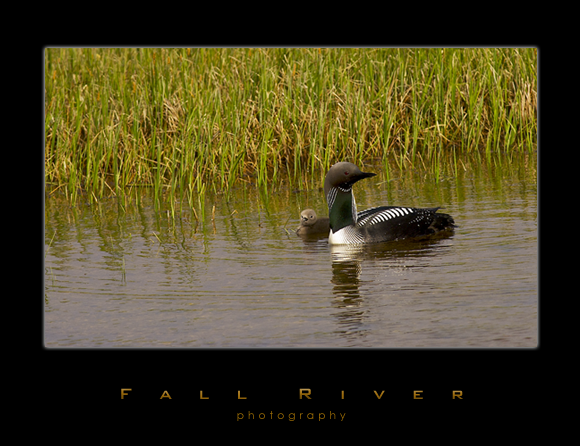
The Arctic Loon has a distinguishing “greenish” iridescent patch on its foreneck that most of the time looks black. From this angle you can see the green. The little chick is all fluffy brown down though at the moment. After being born the chicks down can actually get water logged and they will jump up on Momma’s back for a ride while they dry out. This little guy seemed pretty well on his way to adjusting to his future on the water. He still cannot dive though, too buoyant. When mom or dad dives under he sticks his head down and tries to give chase but just pops right back up like a little cork.
Chicks
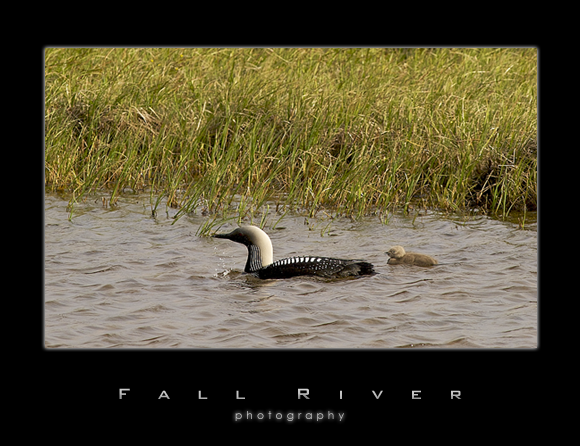
Everybody loves chicks. Loon Chicks are a special treat, and Arctic Loon chicks are too cool. I found this mom and chick squirting around a little pond of water and after some initial hesitation they relaxed and let me observe and photograph. Arctic Loons are an absolutely beautiful bird and I did not realize that they actually can have a very dark green neck, only when the sun hits them just right does it appear anything other than black. This little chick was having a pretty good time but it must have been fed earlier, the day before both mom and dad were working lunch duty, today the action was not so feverish. The little chick had been swimming in between the two of them and just turning its head from one to the other to get whatever it was they were getting from the bottom. Good times.
Lupines

Lupines. Alaska is full of these beautiful flowers everywhere it seems. They are usually the first out for spring and they just light up the roads with their awesome beauty. The wildflower season is just heating up.
Great 4th!
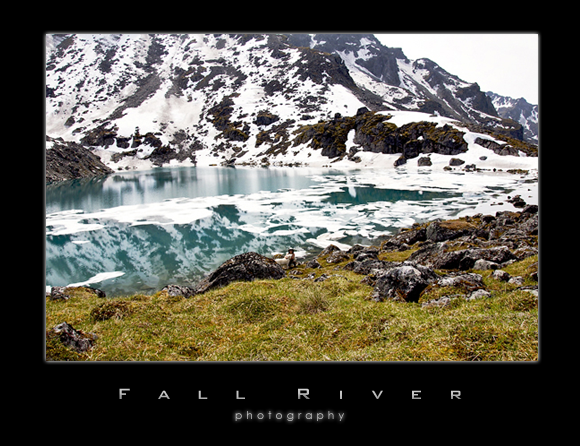
Hope you all had a great 4th of July! We had absolutely great weather and saw some great country. We spent the day up on Dog Sled Pass and had an amazing time. Our town had it’s parade and BBQ’s and everyone was out at the Lake like they were down south somewhere! It is hot and dry for Alaska right now so we have some fire haze…from 60 something fires burning right now. Most are small and are being allowed to burn naturally, a couple are being fought but nothing is really big, let’s hope it stays that way.
On the way to Hope

Hope Alaska sits nestled in a notch on Turnagain Arm about 1.5 hours south of Anchorage. The drive there takes you along the waters of Turn Again and it is spectacular. The tides in Turnagain Arm are the second swiftest tides in the world and when they go out it is like draining a bathtub. In 1888 old man Alexander King rowed a dory up the Cook Inlet into the Turnagain Arm and beached on the south shore. Two years later he rowed out with four pokes of gold, and became a man of great interest. By 1895 five mining partners on Sixmile Creek were spending their 40K in gold around Seattle and suddenly The Rush was on. Three thousand people headed to Sixmile Creek in 1896 and Hope City got its when the miners decided to name the town after the next person that got off the boat – that was Percy Hope – 17 year old prospector extraordinaire.
Reunion!
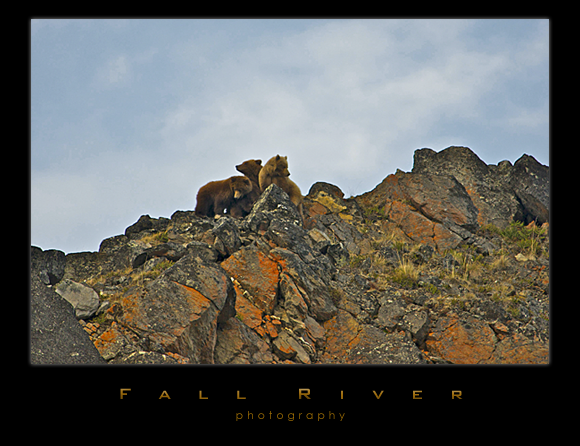
Then the little bear cub spotted her brother! Momma got up and saw him and was visibly relieved. He was more than a half mile away on the side of the next mountain anxiously pacing back and forth. The separation was weighing on them all. The little tike decided to take matters into his own hands and went back across the open valley and up the boulders on the back side of the mountain. Joining up with his sister and Mother meant swinging low on the ridge that the big boar was eyeing them from. We all watched with bated breath as the cub picked his way across the rocks just yards from the male bear who had been sleeping but now was up and calculating his chances. Could he swatch that cub and send it over the cliff and retreat before Momma bear did the same to him?
At last it was over. The cubs and Momma were reunited and the boar was beaten by Momma bear’s preparation, fierceness, and excellent defensive site selection. The big boar laid down again just to make things hard but everyone knew the real danger had passed. Momma could sleep while the cubs watched the old man and then they would move out after he did. No way he was coming up that mountain. It was almost midnight when this photo was taken, what a day.
Looking for Bro
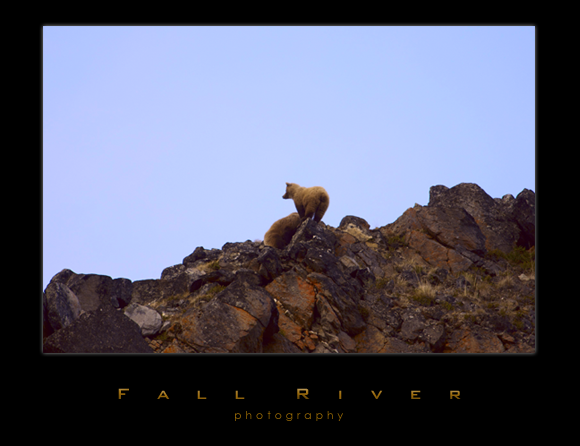
The boar was swinging his massive head as he moved up the mountain saddle toward Momma Bear and the lone remaining cub. Momma Bear had chosen an impeccable defensive position; increasingly steep mountain, loose rock footing and vertical cliff faces as the elevation increased. She backed up the hill as the boar advanced and the cub was extremely anxious. As the mountain ridge reduced to knife edges the boar looked over the side and pushed some rocks to check for footing. No good; if he gets pushed he is going to fall over a hundred feet. He reluctantly turns back down the mountain to the saddle and lies down with a clear view of Momma Bear and baby. He’s going to wait them out.
Momma bear is exhausted from the adrenalin rush of the fight and she is stressed; she cannot find her other cub. The remaining cub is anxiously looking for her brother and his whereabouts are completely unknown. Momma bear cannot risk taking the remaining cub off the mountain top, the boar could catch them and the defensive position she holds is too valuable to the life of her remaining cub. She lies down exhausted; baby bear searches fruitlessly for her brother.
Ursus Horriblious
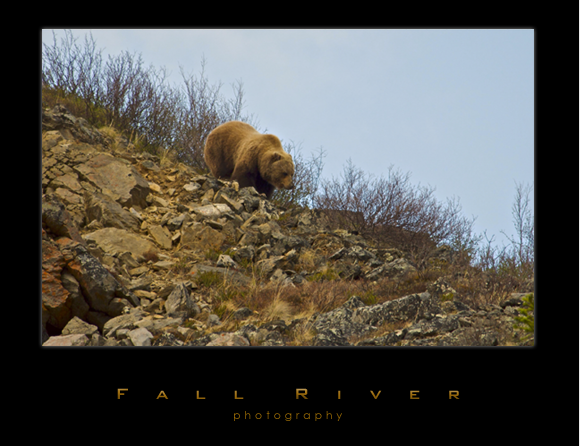
This Bad Boy Boar got within about 20 meters of the sow and cubs while they were grazing and laz’n. They perked up to catch sight of this guy just in time and took off! The boar chased them for about 2 miles up the river and around the bend and up the side of this mountain. Momma turned on the old man about a quarter of the way up and laid into him and had the upper hand as she was on the uphill side. Those cubs were running for their lives! The dark brown cub went up and over the top and kept on running and running while the blonde cub stopped and waited on Momma bear. The sow backed slowly up the hill with the boar swinging his head and menacing his way up the hill in full on attack mode; he wanted that cub. Not good times.
Ursus At Play

These two cubs duked it out for about two hours one late evening. They wrastled and rolled and bit and chewed enough to make us tired. They were some crazy bears and a ton of fun to watch. Got in a few clicks of course. Momma was over to the right taking a nap so these two squared off to kill some time. Good thing they were in shape too; the nasty business of life as a cub bear was soon to brought to full bore.
Eagle Against Pioneer Peak

A couple of Sundays ago we headed out looking for our spring bird arrivals on some old stomping grounds around here in the valley and got some nice shots of a couple of eagles against Pioneer Mountain. The Matanuska-Susitna Valley is famous for it’s views of Pioneer and although the weather was less than steller it was still a great day to be out and about. Other than a couple of eagles though it has been pretty slim pick’ins lately, althought the warm weather should help coax them in as the water thaws. We will be heading down to Homer shortly and that should help out with a bird fix. The Homer bird scene is heating up and we are looking forward to that trip and can hardly wait to go. The famous Homer Spit is a birding HotHouse toward the end of April early May. Check out the links in the blog entry below if you are interested in the Homer Birding Festival.
The Beautiful Mallard
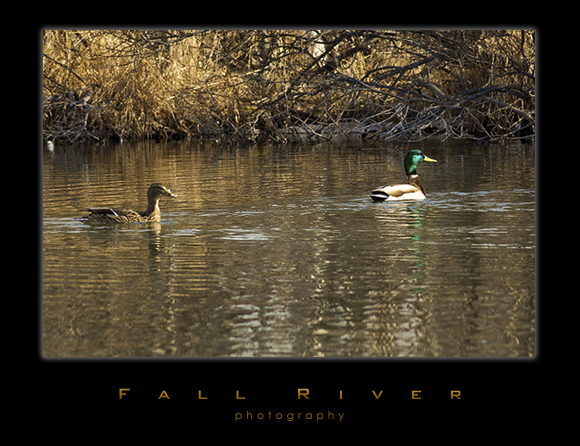
Anas platyrhynchos
Ah yes, the beautiful Mallard. I got to watch Don court this fair lady for a short time, she was a looker too. There were about 30 or so more sitting on the ice about 100 feet away just doing nothing so these two snuck off to flirt. (I was discreet.)
Interesting reading on the Mallard at the Cornell site. http://www.birds.cornell.edu/AllAboutBirds/BirdGuide/Mallard.html
